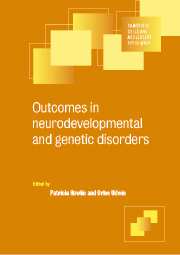Book contents
- Frontmatter
- Contents
- List of contributors
- Preface
- 1 Attention deficit hyperactivity disorder
- 2 Developmental language disorders
- 3 Reading and other specific learning difficulties
- 4 Metabolic disorders
- 5 Hemiplegic cerebral palsy
- 6 Autistic disorders
- 7 Down syndrome
- 8 Fragile X syndrome
- 9 Prader-Willi and Angelman syndromes: from childhood to adult life
- 10 Rett disorder
- 11 Tuberous sclerosis
- 12 Williams and Smith-Magenis syndromes
- Index
3 - Reading and other specific learning difficulties
Published online by Cambridge University Press: 13 August 2009
- Frontmatter
- Contents
- List of contributors
- Preface
- 1 Attention deficit hyperactivity disorder
- 2 Developmental language disorders
- 3 Reading and other specific learning difficulties
- 4 Metabolic disorders
- 5 Hemiplegic cerebral palsy
- 6 Autistic disorders
- 7 Down syndrome
- 8 Fragile X syndrome
- 9 Prader-Willi and Angelman syndromes: from childhood to adult life
- 10 Rett disorder
- 11 Tuberous sclerosis
- 12 Williams and Smith-Magenis syndromes
- Index
Summary
Background
Interest in following children with specific learning difficulties (SLD) into adulthood has increased considerably over the past decade (e.g. Patton & Polloway, 1992). Researchers are increasingly asking how children with SLD perform in secondary school, whether they enter and/ or graduate from post secondary programmes and how they fare in the adult working and social worlds. An important consideration when examining the characteristics of adults with SLD concerns the unique demands and problems that arise in adulthood because of increased vocational, relationship and independence demands that were not as prominent during childhood.
In addition to differences between childhood and adult environments, the population with SLD is itself extremely diverse. For example, adults with SLD vary greatly in severity and types of processing deficits, reflecting both individual strengths and weaknesses as well as the underlying aetiology of their various forms of SLD. Additionally, wide variation in cognitive ability, language skills, cultural backgrounds and personality characteristics will effect outcome in adulthood. Given this variability, it would be a mistake to assume that outcome within any domain can be uniformly predicted. This variability has implications for interpreting the findings of most studies examining outcomes in adults with SLD. Many studies combine different subgroups of individuals together, regardless of the specific type of SLD they show (e.g. Sitlington & Frank, 1990; Levine & Edgar, 1995; Blackorby & Wagner 1996). This is to ensure sample sizes large enough to make meaningful comparisons.
Keywords
- Type
- Chapter
- Information
- Outcomes in Neurodevelopmental and Genetic Disorders , pp. 56 - 73Publisher: Cambridge University PressPrint publication year: 2002
- 1
- Cited by

